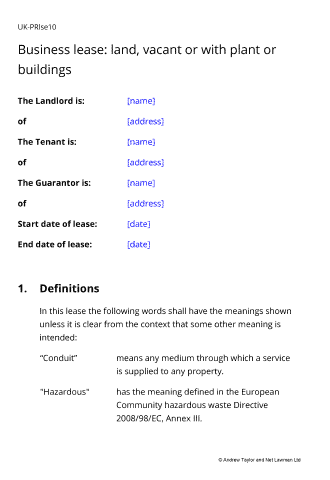Business lease

Document overview

 England & Wales
England & Wales Scotland
Scotland

- Length:26 pages (7700 words)
- Available in:
 Microsoft Word DOCX
Microsoft Word DOCX Apple Pages
Apple Pages RTF
RTF

If the document isn’t right for your circumstances for any reason, just tell us and we’ll refund you in full immediately.

We avoid legal terminology unless necessary. Plain English makes our documents easy to understand, easy to edit and more likely to be accepted.

You don’t need legal knowledge to use our documents. We explain what to edit and how in the guidance notes included at the end of the document.

Email us with questions about editing your document. Use our Lawyer Assist service if you’d like our legal team to check your document will do as you intend.

Our documents comply with the latest relevant law. Our lawyers regularly review how new law affects each document in our library.
About this agreement
This lease is for letting land that may or may not include buildings or items of plant and machinery.
The property could be used for any purpose, from plant or equipment storage, to a scrap yard, to a garden centre or timber yard or farmers’ marketplace.
Provided the term of the lease is seven years or less, it does not need to be registered at the Land Registry.
Similar agreements
If the land is to be used for parking agricultural vehicles, lorries or cars, then this agreement is more suitable.
We also sell a similar version of this agreement that contains the following less commonly required terms:
- provisions for sub-letting
- provisions for an authorised guarantee agreement
- extensive landlord's warranties
- references to land registration for leases with a term greater than 7 years
- prescribed lease clauses
Key features
Plain English is used throughout except where it is necessary to use legal terms common in this field of law.
The key features of this agreement can be summarised as:
- standard guarantor
- options for transfer or assignment to another party
- sub-letting forbidden
- option to include a break clause for premature termination by the tenant
- a choice of options for rent reviews
- opt-out of sections 24-28 of the LTA 1954
The law in this document
Law with respect to letting land is regulated primarily by the Landlord and Tenant Act 1954, amended many times.
Account has also been taken of:
- the Landlord and Tenant (Covenants) Act 1995
- the Regulatory Reform Regulations 2003
- the Joint Committee's Code for Leasing Business Premises
- the RICS' Code on Service Charges
We have followed the codes where reasonable, but have always preferred the interest of the landlord.
Contents
This template is comprehensive, providing alternative choices for important decisions.
The contents include 30 main provisions and 2 schedules covering:
- rent: amount, other payments, interest on overdue rent, periodic review
- condition and repair
- tenant's positive obligations
- restrictions on tenant: prohibited activities on the property
- signs and advertisements
- goods and vehicles
- assignment of the lease
- indemnities by the tenant
- security deposit
- insurance
- access for landlord
- guarantor
- termination: default notice by landlord; provision for premature termination (a break clause)
- forfeiture
- security of tenure excluded
- Schedule 1: rights reserved
- Schedule 2: draft agreement for a security deposit agreement
Scottish version
The law governing commercial leases is substantially different in Scotland as compared with England, Wales and Northern Ireland. In Scotland there is no equivalent to the Landlord and Tenant Acts. There is little legislation or case law relating to leases in Scotland. So the version we have drawn for our Scottish user is common law based.
On registration of leases in Scotland, only commercial leases for longer than 20 years must be registered in the Land Register of Scotland. However, the lease is often registered in the Books of Council and Session in Edinburgh.

Recent reviews
Choose the level of support you need
Document Only
This document
Detailed guidance notes explaining how to edit each paragraph
Lawyer Assist
This document
Detailed guidance notes explaining how to edit each paragraph
Unlimited email support - ask our legal team any question related to completing the document
- Review of your edited document by our legal team including:
- reporting on whether your changes comply with the law
- answering your questions about how to word a new clause or achieve an outcome
- checking that your use of defined terms is correct and consistent
- correcting spelling mistakes
- reformatting the document ready to sign
All rights reserved
